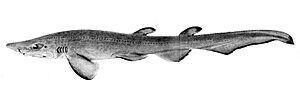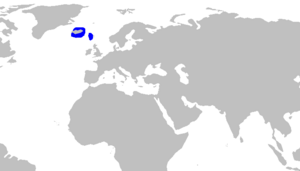Mouse catshark facts for kids
Quick facts for kids Mouse catshark |
|
|---|---|
 |
|
| Conservation status | |
| Scientific classification | |
| Genus: |
Galeus
|
| Species: |
murinus
|
 |
|
| Range of the mouse catshark | |
| Synonyms | |
|
Pristiurus jensenii Saemundsson, 1922 |
|
The mouse catshark (Galeus murinus) is a type of catshark. It belongs to the family called Scyliorhinidae. These sharks are often found in the northeastern Atlantic Ocean. Their home ranges from Iceland all the way down to Western Sahara.
This shark usually grows to about 49 cm (19 in) long. It has a plain brown body. You can recognize it by its big, round pelvic fins. It also has special ridges of large, tooth-like scales called dermal denticles. These ridges run along the top and bottom edges of its tail fin. In adult male mouse catsharks, the inner edges of their pelvic fins join together. This forms a shape that looks like an "apron."
The mouse catshark lives near the bottom of the ocean, which means it is a demersal animal. It lives on continental slopes, in waters that are 380–1,300 m (1,250–4,270 ft) deep. It mostly eats benthic crustaceans, bony fishes, and cephalopods. Female mouse catsharks lay eggs in special "furry" egg capsules. Even though fishing boats sometimes catch them by accident, these sharks are not considered endangered. The International Union for Conservation of Nature (IUCN) lists them as "Least Concern."
Contents
About the Mouse Catshark Name
A Norwegian zoologist named Robert Collett first described the mouse catshark in 1904. He called it Pristiurus murinus. The second part of its name, murinus, comes from Latin. It means "relating to a mouse."
Scientists later decided that Pristiurus was actually the same as the Galeus group of sharks. So, the mouse catshark's scientific name became Galeus murinus. There has been some confusion about this species, especially with sharks found near Iceland. Some scientists think these might be a slightly different type of shark.
Where Mouse Catsharks Live
The mouse catshark is quite common. Scientists have recently found that it lives in more places than they first thought. It can be found in the northeastern Atlantic from western Iceland and the Faroe Islands. It also lives near the Hebrides, Scotland, and Ireland. Its range extends south to France and Western Sahara.
These sharks live on or close to the ocean floor. They prefer the continental slope areas. They are found in waters that are 380–1,300 m (1,250–4,270 ft) deep.
What Mouse Catsharks Look Like
The mouse catshark can grow up to 49 cm (19 in) long. Some reports from Iceland suggest they might be larger, up to 85 cm (33 in). However, this might be due to confusion with a similar species.
This shark has a firm body and a snout that is quite long and blunt. Its nostrils are split by small flaps of skin. The eyes are oval-shaped and have basic protective eyelids, called nictitating membranes. There's a small ridge under each eye and a tiny hole called a spiracle behind them. Its mouth is wide and curved, with grooves at the corners. The teeth have a sharp point in the middle and smaller points on each side. It has five pairs of gill slits.
The first dorsal fin (on its back) has a rounded tip. It sits above the back part of the pelvic fins. The second dorsal fin is similar in size and shape. It is located above the back part of the anal fin. The pectoral fins (on its sides) are large and wide.
The pelvic fins are special. They are large and wide with a smooth, rounded edge. In adult males, the inner edges of these fins are joined together. This forms an "apron" that partly covers their claspers. The anal fin is large and angled. Its base is much longer than the space between the dorsal fins. The pelvic, anal, and caudal fins (tail fin) are all very close to each other.
The part of the body before the tail, called the caudal peduncle, is round. The tail fin is low, with a small lower part. It also has a notch near the tip of the upper part. The shark's skin is covered in small, overlapping dermal denticles. Each denticle looks like an arrowhead with a ridge and three small teeth. There is a clear ridge of larger denticles along the top edge of the tail fin. Unusually for this type of shark, there's also a similar ridge of denticles along the underside of the caudal peduncle. This ridge extends to the front part of the bottom edge of the tail fin. The mouse catshark is plain brown, but its underside is a bit lighter. The inside of its mouth is dark.
Mouse Catshark Diet and Life Cycle
The mouse catshark mainly eats shrimp, like Pasiphaea multidentata and Sergestes robustus. It also eats other crustaceans, such as Dorhynchus thomsoni. Its diet includes bony fishes, like Micromesistius poutassou, and cephalopods. Most of the food it eats is found on or near the sea floor.
Mouse catsharks reproduce by laying eggs, which means they are oviparous. The female shark has two tubes for eggs, called oviducts. One egg develops in each tube at a time. The egg capsules are golden yellow and shaped like a vase. They are about 5.4–5.6 cm (2.1–2.2 in) long and 1.4–1.7 cm (0.55–0.67 in) wide. The top of the capsule is flat, and the bottom has a short point. The surface of the capsule is covered in many fibers, which makes it look hairy. Young mouse catsharks are thought to hatch when they are about 8–9 cm (3.1–3.5 in) long.
Mouse Catsharks and Humans
Fishing boats often catch mouse catsharks by accident. This happens when commercial trawl fisheries are fishing in deep waters off Europe and western Africa. However, these sharks might be small enough to escape most fishing nets. Also, there are likely many areas where they live that are not heavily fished. Because there are no major threats to their population, the International Union for Conservation of Nature (IUCN) has listed this species as "Least Concern." This means they are not currently at risk of disappearing.


